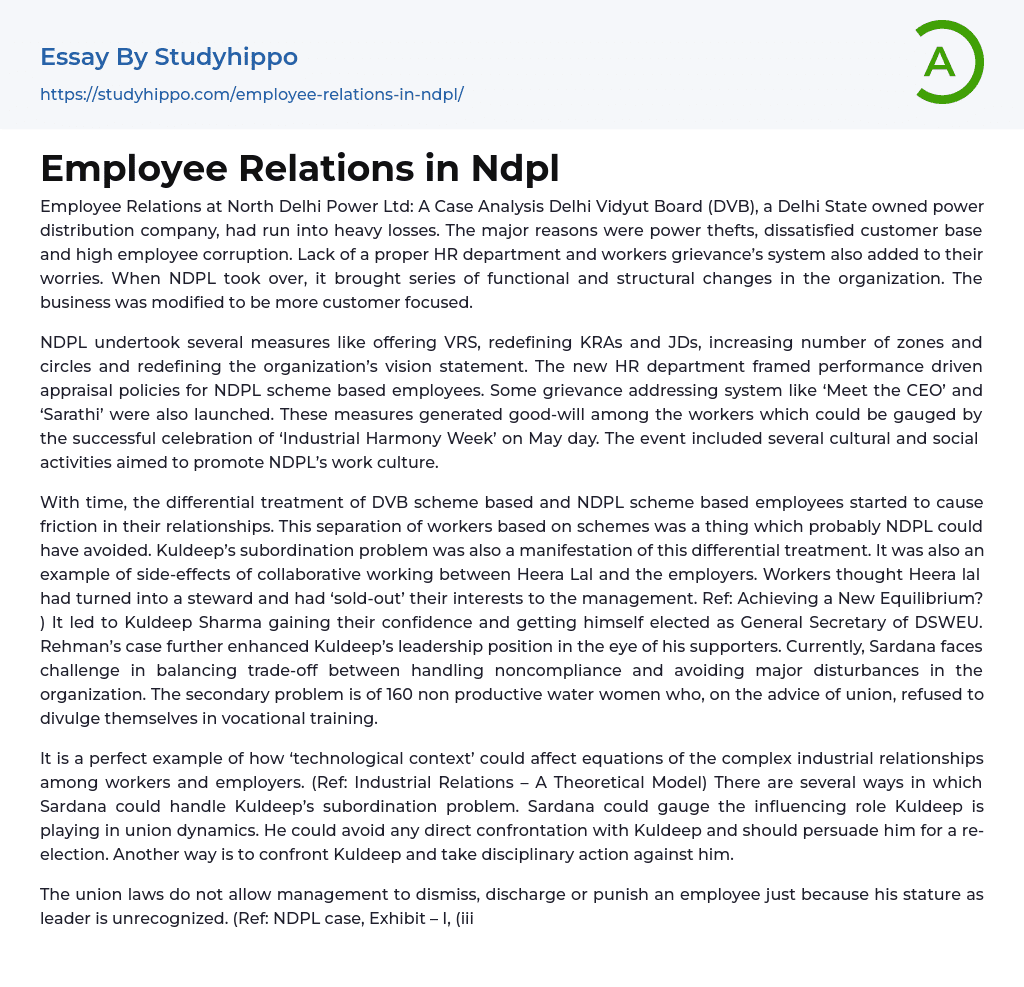The case analysis examines the employee relations at North Delhi Power Ltd. The company, which is a state-owned power distribution company called Delhi Vidyut Board (DVB), faced significant challenges including heavy losses due to power thefts, dissatisfied customers, and high employee corruption. In addition, the lack of a proper HR department and a system for addressing workers' grievances only compounded their concerns. However, after NDPL took over, several functional and structural changes were implemented to make the business more customer-focused.
NDPL implemented various strategies to enhance employee satisfaction, such as offering voluntary retirement schemes (VRS), revising key result areas (KRAs) and job descriptions (JDs), expanding the number of zones and circles, and redefining the organization's vision statement. The HR department introduced performance-driven appraisal policies specifically for NDPL scheme-based employees. Addit
...ionally, grievance addressing systems, including 'Meet the CEO' and 'Sarathi', were introduced. These measures resulted in positive sentiment among workers, as evidenced by the successful celebration of 'Industrial Harmony Week' on May Day. The event featured a range of cultural and social activities designed to promote NDPL's work culture.
Over time, the differential treatment of employees based on the DVB scheme and the NDPL scheme began to cause friction in their relationships, which could have been avoided by NDPL. Kuldeep's issue of subordination was a result of this differential treatment and a consequence of collaborative working between Heera Lal and the employers. Workers believed that Heera Lal had become a steward and had prioritized the interests of management, leading to Kuldeep Sharma gaining their trust and being elected as General Secretary of DSWEU. Rehman's case further solidified Kuldeep's leadership position among his supporters. Currently, Sardan
is faced with the challenge of balancing noncompliance handling and preventing major disturbances in the organization. Additionally, there is a secondary problem involving 160 non-productive water women who, following union advice, have refused to participate in vocational training.
It is a prime demonstration of how the 'technological context' can impact the intricacies of the relationships between workers and employers in the industrial sector (Ref: Industrial Relations - A Theoretical Model). There are various approaches that Sardana can employ to address Kuldeep's issue of subordination. Firstly, Sardana can evaluate the influential role that Kuldeep plays in the dynamics of the union. Secondly, instead of engaging in direct conflict with Kuldeep, Sardana should endeavor to convince him to participate in a re-election. Alternatively, Sardana can choose to confront Kuldeep and impose disciplinary measures on him.
According to the union laws, it is not permissible for management to dismiss, discharge, or punish an employee solely due to their unrecognized leadership position (Ref: NDPL case, Exhibit - I, (iii)). However, in the case of Kuldeep and his rebellious and noncompliant supporters, they could potentially face charges of subordination as they are bound by the Code of Discipline in Industries (Ref: Exhibit III). I would recommend pursuing the second approach as any deviation from industrial standards should be dealt with strictly. It is essential to address the underlying conflict between DVB and NDPL scheme-based employees.
According to Ranabir Samaddar's case study mentioned in the newspaper article, there is a widespread belief among workers that technology is used by management to undermine trade unions. Management needs to prioritize raising awareness about fairness and job security among employees in the DVB
scheme. Dealing with the dilemma of deciding the fate of 160 female water workers is challenging. These women workers declined vocational training because they sought the job security provided by government employment.
The history of Indian industrial relationship suggests that union bargaining efforts often do not yield significant results. Over time, both government and private sectors have reduced their workforce to create a more streamlined organization structure (Ref: Labour and Change). It is important to provide women workers with a voluntary retirement scheme (VRS) option and help them understand the reasoning behind it. If they choose not to accept the VRS option, they should be offered vocational training as an alternative. If they continue to show disinterest, termination from their services should be considered. Submitted by: Shakti Prakash Chittara MBA FT - 071
- Career Choice essays
- Career Goals essays
- Career Plan essays
- Community Service essays
- Dream Job essays
- Duty essays
- Employee essays
- Internship essays
- Interview essays
- Job essays
- Job Interview essays
- Performance Appraisal essays
- Portfolio essays
- Service essays
- Skills essays
- Vocation essays
- Work Experience essays
- Work-Life Balance essays
- American Dream essays
- Barriers To Entry essays
- Capitalism essays
- Central Bank essays
- Compensation essays
- Consumerism essays
- Economic Development essays
- Economic Growth essays
- Economic Inequality essays
- Economic System essays
- Economy essays
- Employment essays
- Export essays
- Finance essays
- Free Trade essays
- Gross Domestic Product essays
- Human Development essays
- Income Inequality essays
- Industry essays
- Inflation essays
- International Business essays
- International Trade essays
- Macroeconomics essays
- Materialism essays
- Max Weber essays
- Microeconomics essays
- Minimum Wage essays
- Monetary Policy essays
- Monopoly essays
- Pricing essays
- Profit essays
- Recession essays




